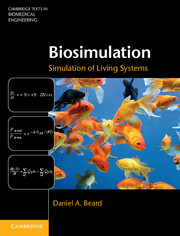Book contents
- Frontmatter
- Contents
- Preface
- Extracts
- 1 Introduction to simulation of biological systems
- 2 Transport and reaction of solutes in biological systems
- 3 Physiologically based pharmacokinetic modeling
- 4 Cardiovascular systems simulation
- 5 Chemical reaction systems: thermodynamics and chemical equilibrium
- 6 Chemical reaction systems: kinetics
- 7 Chemical reaction systems: large-scale systems simulation
- 8 Cellular electrophysiology
- 9 Appendices: mathematical and computational techniques
- References
- Index
8 - Cellular electrophysiology
Published online by Cambridge University Press: 05 June 2012
- Frontmatter
- Contents
- Preface
- Extracts
- 1 Introduction to simulation of biological systems
- 2 Transport and reaction of solutes in biological systems
- 3 Physiologically based pharmacokinetic modeling
- 4 Cardiovascular systems simulation
- 5 Chemical reaction systems: thermodynamics and chemical equilibrium
- 6 Chemical reaction systems: kinetics
- 7 Chemical reaction systems: large-scale systems simulation
- 8 Cellular electrophysiology
- 9 Appendices: mathematical and computational techniques
- References
- Index
Summary
Overview
This chapter is devoted to the study and simulation of the electrical potential across cell membranes. Practically every type of animal cell actively maintains an electrostatic potential difference between its cytoplasm and external milieu. Organelles in the cell, such as mitochondria for example, maintain electrical gradients across their membranes as well. The electrostatic gradient across cell membranes changes dynamically in response to chemical, mechanical, and/or electrical stimuli. In turn, dynamic changes in cell membrane potential are tied to all manner of downstream processes in various cell types. For example, muscle cells contract when calcium ions enter the cytoplasm in response to depolarization of the cell membrane potential. Depolarization, caused by the influx of sodium and other positively charged ions, may be initiated by the combined action of several processes, including stimulation by neurotransmitters and transmission of the electrical signal from neighboring cells.
The focus here is on simulating the dynamics of the cell membrane potential difference, and the ion currents that influence changes in the potential difference. A substantial fraction of the chapter is devoted to working through the details of the celebrated Hodgkin–Huxley model of the nerve impulse. This exposition allows us to introduce the basic formulation of that classic model, which is still widely used in the field. Reviewing the work of Hodgkin and Huxley allows us to see how their model was developed based on data from experiments carefully designed to reveal a quantitative description of the biophysical processes at work.
- Type
- Chapter
- Information
- BiosimulationSimulation of Living Systems, pp. 230 - 261Publisher: Cambridge University PressPrint publication year: 2012

